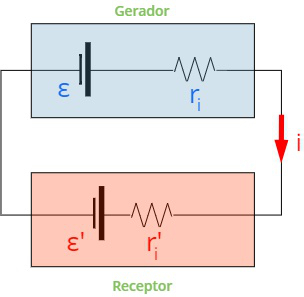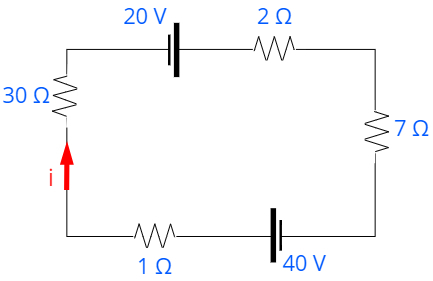Pouillet's Law is an expression used to determine the intensity of the electric current that runs through a simple mesh. simple knits are electric circuits closed, without branches. Pouillet's law states that the electric current in these meshes corresponds to the difference between the forces electromotive and counter-electromotive, divided by the sum of the electrical resistances of each element present in the mesh.
Pouillet's law derives from a law of conservation of energy more general, called Kirchoff's lattice law, which can be applied to more complex electrical circuits. However, in simpler cases, the use of Pouillet's law is more advantageous, given its simplicity.
Furthermore, every year a large number of electrodynamics exercises appear in the And either and in other entrance exams, which can be solved simply and quickly if we correctly apply the law in question.
Lookalso: Ohm's law - one of the most important in electrodynamics
Pouillet's Law
Pouillet's law allows you to calculate the modulus of the electrical current established along a grid. Meshes, in turn, are closed paths within an electrical circuit. According to this law, the electric current is equal to the sum of the electromotive forces minus the sum of the counter-electromotive forces, the result of which is divided by the total resistance of the mesh. Observe the following figure, in it we bring Pouillet's law in its general form:

ε and ε' – electromotive force and counter-electromotive force (V – volts)
R, Ri and r'i - sum of electrical resistances of resistors, generators and receivers
How to use Pouillet's law
To make calculations with Pouillet's law, it is necessary to know who the generators and who are the receiversgifts in the mesh. So you must know the electric current direction so that we can then identify which elements are present in the mesh.
Knowing the direction of the current, it is enough to remember that electric generators are always crossed from the lowest potential to the highest potential (smaller bar and larger bar, respectively), while the current that passes through the receivers reaches the highest potential and leaves it through the lower terminal potential.
The next figure exemplifies how we can identify the generators and receivers in the circuits:

Generators are traversed from smallest to greatest potential, while receivers do it from smallest to largest.
After identifying the generators and receivers, we need to remember that the generators produce electromotive force and receivers consume it. The amount of energy each receiver needs to operate is called the strengthcounter electromotive. Therefore, in Pouillet's law, the difference between the energy that is produced by the generators and that consumed by the receivers is taken into account.
Example of Pouillet's Law
In this topic we show an example of a circuit that can have its electrical current easily determined by applying Pouillet's law, see:
In a grid, there is a real electrical generator, with an electromotive force equal to 10 V and an internal resistance equal to 1 Ω, connected to an electric motor with counter electromotive force equal to 8 V, electrical resistance equal to 1 Ω. As shown in this figure:

Where ε = 10 V, ε' = 8 V, ri = 1 Ω, and r'i = 1 Ω, determine, by means of Pouillet's law, the intensity of the electric current that passes through the circuit:
Resolution:
The example speaks of a circuit formed exclusively by a generator connected to an electric motor. Knowing this, we will apply the information provided in Pouillet's law formula:

Lookalso:Uniform movement - concept, formulas and exercises
Solved exercises on Pouillet's law
Question 1) Observe the electrical circuit illustrated in the following figure:

Using Pouillet's law, determine the intensity of the electrical current formed in this circuit and mark the correct alternative:
a) 1.0 A
b) 1.5 A
c) 2.5 A
d) 5.0 A
e) 7.5 A
Template: Letter B
Resolution:
Before solving the exercise, we must carefully observe the direction of the electric current. By doing this, we notice that there are two generators in the illustrated mesh, since the only two elements of the circuits that are not resistors are carried by the electric current from the smallest to the largest potential. Once that's done, we just apply Pouillet's law:

Based on the calculations performed, we find that the electrical current formed in the circuit is equal to 1.5 A, so the correct alternative is the letter b.

Question 2) In a closed loop, there are three real and identical generators associated in series. It is known that their electromotive forces are equal to 1.5 V and that their electrical resistances are 0.25 Ω. If this set of generators is connected to an ideal small electric motor, with a counter-electromotive force equal to 3.0 V, what will be the intensity of the electric current that will pass through it?
a) 0.5 A
b) 1.5 A
c) 2.0 A
d) 5.0 A
e) 3.5 A
Template: Letter C
Resolution:
To solve the exercise, we will use Pouillet's law, so we add up all the electromotive forces of the generators and then subtract the counter-electromotive force of the receiver. Note the calculation in the following figure:

According to the calculations, the electrical current that forms in this circuit is 2.0 A, so the correct alternative is the letter c.
By Rafael Hellerbrock
Physics teacher
Source: Brazil School - https://brasilescola.uol.com.br/fisica/lei-de-pouillet.htm
